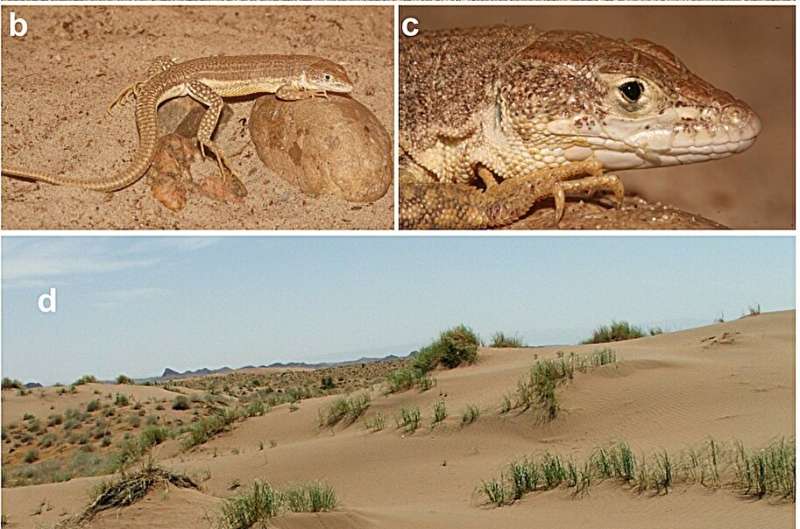Eremias graphica sp. nov.: a–c; d: Habitat at the type locality. Credit: Zootaxa (2023). DOI: 10.11646/zootaxa.5369.3.2
A team of zoologists and biologists affiliated with several institutions in Russia and Iran has identified two new species of racerunner lizards in Iran. In their paper published in the journal Zootaxa, the group describes where the lizards were found, their features and how they fit in with other racerunner lizards.
In 2010, a group of unique-looking racerunner lizards were found living along a road near the city of Tabas, approximately 55 kilometers from Tehran. Recently, a team was put together to actively study the find.
In this new effort, the research team ventured to the site where the lizards had been observed and studied 10 of the specimens they found on site.
The researchers noted that all the lizards had distinctive hieroglyphic patterns on their backs—something that had not been seen before in racerunner lizards—though there seemed to be two groupings of lizards with slightly different patterns.
The team found that the average length of the lizards was approximately 18 cm, and the unique coloring on their backs and bodies allowed them to blend well with the desert habitat. They also noted that the lizards tended to sit still atop rocks or patches of sand and at times ran beneath nearby bushes to cool down or capture prey.
A closer look revealed that the lizards all had dark brown squiggles on their backs—the hieroglyphic pattern that had previously been observed. They also had long tails, nearly twice the length of their bodies, and dark brown eyes and sharp claws. And like most desert dwellers, they were found to be most active during the morning and evening hours.
The research team euthanized some specimens and brought them back to their lab for DNA analysis, determining that they were indeed two new species. The team promptly named them Eremias graphica, and Eremias pseudofasciata, after the patterns on their backs and their membership in the group racerunner.
Racerunners, as their name suggests, are known for their speed. Several species have been clocked running as fast as 28 km/hour.
More information: VALENTINA F. ORLOVA et al, Taxonomic diversity of racerunners with descriptions of two new Eremias species (Sauria: Lacertidae) from Central Iran, Zootaxa (2023). DOI: 10.11646/zootaxa.5369.3.2
Journal information: Zootaxa
© 2023 Science X Network
























